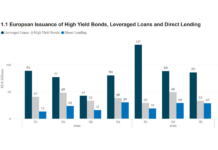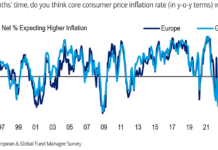While credit ratings underline investor confidence and evaluation of debt products, credit risk data can potentially offer a more nuanced source of information for investors, issuers and traders, on a shorter term basis. The DESK’s Risk&Return spoke with Zane Van Dusen, Bloomberg’s global head of risk & investment analytics products to assess the use and value of this data as an input.
The DESK: How commonly do you see disparity between credit ratings of debt and the market pricing of credit risk for debt?
Zane Van Dusen: This is something we see often, especially within Bloomberg’s Enterprise Data business where we’re looking at thousands of names on a regular basis. In many cases, our clients are essentially trying to identify where market pricing or some other external factor is misaligned with a credit rating, because that’s usually a signal that something is an opportunity or potential risk. There might be a downgrade or upgrade on the horizon, and we see this most commonly when there’s very active news around a particular company.
Credit ratings are generally trying to capture the long-term view through-the-cycle, but oftentimes people also want point-in-time metrics to see how impactful a news story has been on a particular company or sector, or who was the most affected versus least affected. That’s generally where you see divergence from what’s reflected in a credit rating versus market pricing, and in some cases, this divergence can be ahead of a downgrade.
TD: Is it more common to see that disparity with one ratings agency or multiple, and if you’ve got a disparity with multiple, how does that balance with any rating change?
ZVD: The fixed income business is usually looking at an aggregated consensus to come up with the benchmark of where a firm sits. In general, agencies are aligned with each other within one or two notches. Whereas a market implied signal might give you something that’s multiple notches away because it’s telling you there’s some really important news going on with that particular company.
In general, when people are looking at the risk analytics data we offer, they’re usually looking at one group they’ve condensed into the rating category, then they have their market implied quantitative signals as another input, potentially bringing in other things like news sentiment as well.
TD: If I was a credit ratings agency and I saw these disparities happening, I’d probably arbitrage that gap by using the credit data myself; do they?
ZVD: In general, they are pretty separate from us. They view us as alternative solutions, so we generally don’t do a lot of work together. However, firms will likely bring in both our credit analytics alongside credit ratings.
TD: Are there common factors that you see creating disparities between ratings and market pricing?
ZVD: Absolutely. Usually it’s driven by news that’s happening for names people are closely monitoring. It’s important to clarify that, it’s not just headline news, it can be little things for someone who’s really close to a specific sector.
For example, if you are a credit analyst or a trader focused on the automobile sector, you know that sector really well and minor changes about specific companies are super important. That’s where you often start to see those disparities between the front and back office crop up, because through-the-cycle credit ratings from ratings agencies are less interested in capturing that very specific, minute movement.
The front office is attuned to this movement but a lot of folks in the risk management space are sitting in the back office where they’re looking at thousands of things across different sectors and they just see an investment grade rating. However, for example, when you see a bond trading at 80 or 70, the front office person knows very intuitively that the rating the back office person is referencing might need to catch up with the current pricing.
We try to distil that front office insight with our market-implied probability of default (MIPD) solution. We take bond market data and translate that into something like a credit grade, so that someone can incorporate changes into their framework and identify those discrepancies.
TD: What’s the primary indicator?
ZVD: Market implied is usually the leading indicator because it captures what’s happening in fixed income markets, which is where the institutional investors are, and they are usually the first to move.
TD: How is private credit assessed?
ZVD: From a public credit perspective, we’re focused on trying to filter through the noise to find key insights from all data that’s available.
In private credit, where there’s less standardised reporting, it’s more about trying to figure out which insights we can get access to. Generally, you’re searching for whatever data that’s available and appropriate proxies. A good example is our collaboration with Credit Benchmark. We brought their data onto the Terminal and through Data License for enterprise-wide use. Credit Benchmark aggregates credit metrics from banks so any company that has exposure to a bank will be rated by the banks’ internal ratings process, which Credit Benchmark collects to build credit consensus ratings. That’s valuable because usually those banks have information that might not be publicly available about private companies. We can’t access it, but we get the end result which is a credit consensus rating, as well as descriptive analytics.
That’s a really powerful starting point.
The other element we have is Bloomberg’s DRSK solution, which has a specific model for private companies. We take Bloomberg financial data for private companies and layer that with market data. For public companies, we can look at equity share price, but since that’s not possible for private companies, we leverage sector and regional market data to come up with reasonable proxies. We might look at the company’s balance sheet so that we can come up with a baseline default probability, but we want to understand how it would change over time.
A lot of private credit company valuations don’t change very frequently, so having this proxy from a sector level gives us a good sense based on how things like interest rates and sector specific events affect prices to give us a daily indicator. Even though this data is not available daily, we want to be able to produce daily credit scores for our clients.
TD: Do you take any qualitative inputs? If so, how do you integrate them?
ZVD: My business has primarily focused on trying to distil qualitative inputs into quantitative inputs. A good example is on the market side of our MIPD product.
Rather than trying to get news sentiment from articles and social media, we find it a lot easier to quantify those insights from bond pricing. This is possible because we have strong pricing from BVAL, our evaluated pricing service, that captures pricing for any company that’s currently issuing debt, meaning we are going straight to the source. For emerging risks that people need for climate or geopolitical assessment, we’re trying to identify how to turn those into a number, rather than just a good/bad indicator.
TD: How does using the credit data on the Terminal get crossed with data from sources outside of the Terminal?
ZVD: For research and analysis to be pulled down for wider use throughout a firm, clients subscribe to a data feed through Data License to access Bloomberg’s credit risk indicators which include MIPD and our default risk structural credit model (DRSK), then they’re able to plug that data into their own models. Then, if you have an interesting alternative data set specific to your industry, you can combine our data with that to come up with your final credit grade.
It’s going to be everyone’s own interpretation of the mosaic of credit factors. There is news sentiment, fundamentals, internal data, and I want to give people the ingredients so they can do the final weighting to assess the importance of X versus Y versus Z to come up with their own internal credit rating or score or a buy/sell/hold threshold. People want to integrate all this data and apply their own secret sauce, which is why MIPD and DRSK are valuable, because they can plug it into their own model and framework.
©Markets Media Europe 2024
©Markets Media Europe 2025













